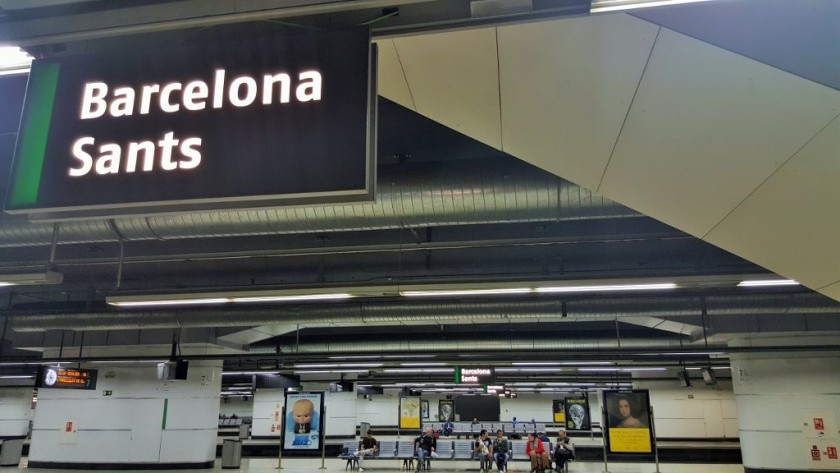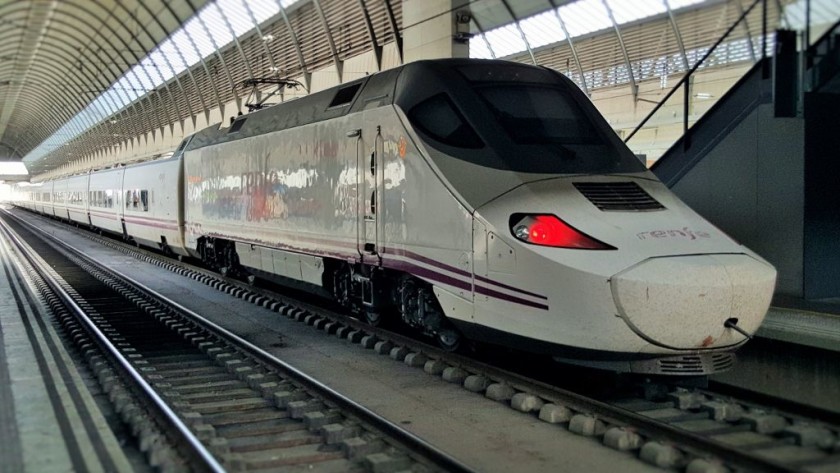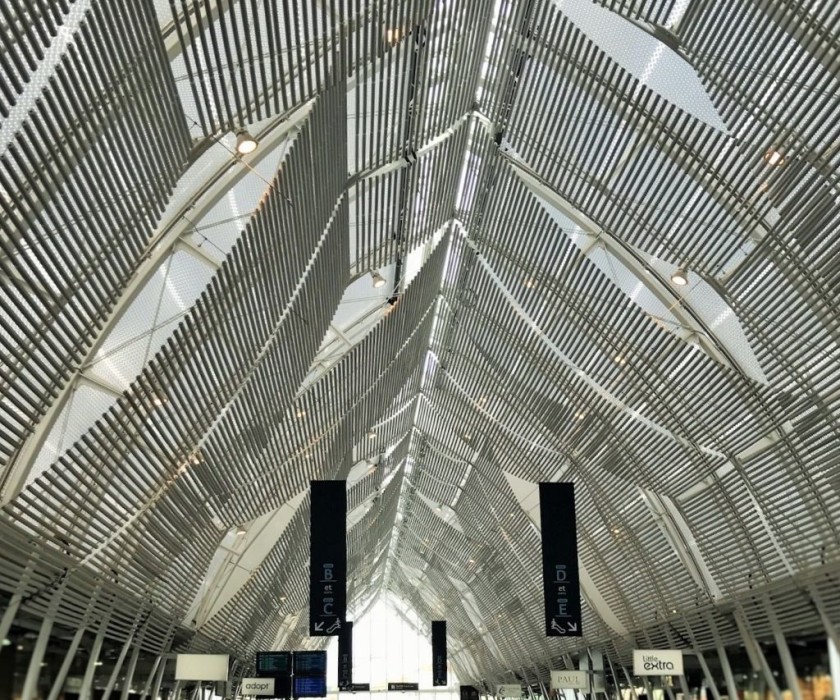Related Content
Content

Madrid Atocha / Puerta De Atocha (Madrid)
Madrid Atocha station can be a bewildering space to navigate if you are a first time user - hence this guide to what to look out for when arriving and departing from here by train.
Share
At a Glance
Services
Travel Information Desk
First Class Lounge
Local Tourism Information
Onward Travel
Metro
Car Hire
Taxi Rank
Accessibility
Step Free
Misc
Terminus Station
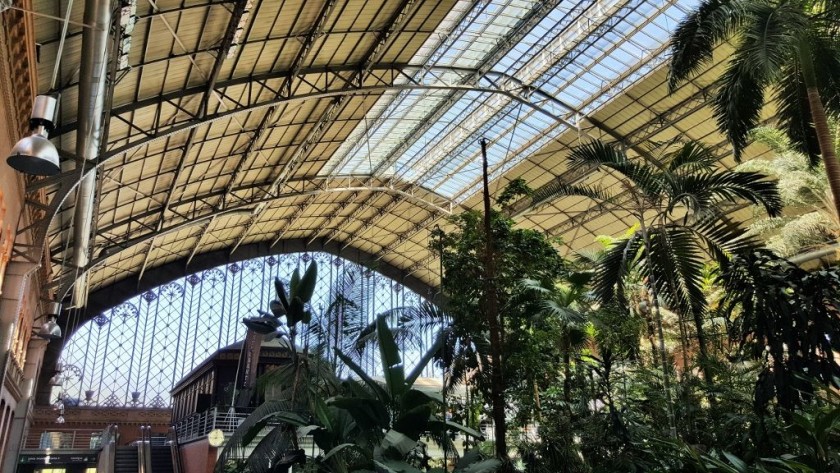
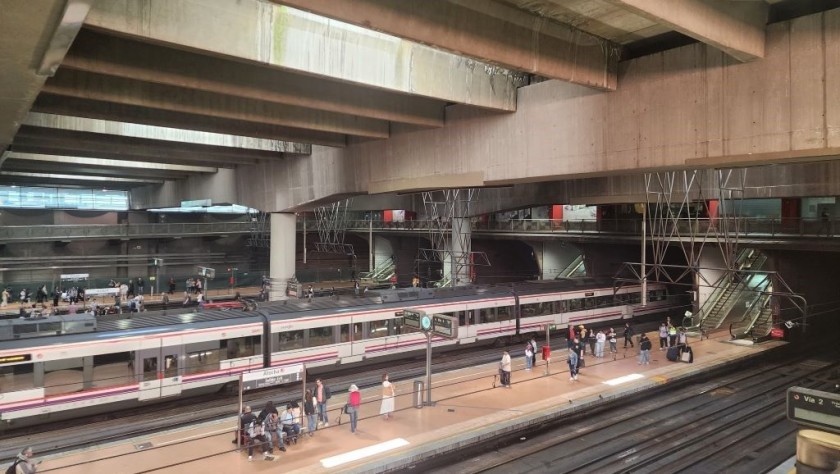
Irrespective of an interest in modern architecture, it's undeniable that Madrid's primary rail station has the power to make an impact, particularly when arriving on a high speed train.
It is the scale of the Puerta de Atocha high speed station that has earned it a place on our list of Awe Inspiring Stations and yes the indoor garden/jungle also can't fail to impress.
It's a huge building, but the trick to understanding how Madrid Atocha functions, is to set aside assumptions of how you would normally use a railway station; hence the detailed, but useful info.
Good to know


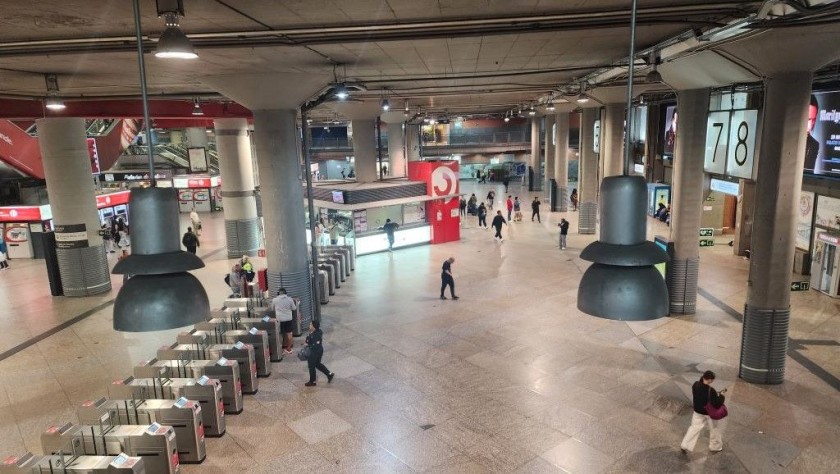

Six things worth knowing bout Atocha station:
(1) The signage within the station is comparatively easy to follow and is bi-lingual; so you can trust it to navigate your way through the vast complex.
(2) Madrid Atocha in effect three stations in one building:
- the main terminal, known as Puerta De Atocha, which is the part of the station used by the high speed trains.
- the Cercanias station used by the local trains (the Cercanias trains), the Media-Distancia trains; and a few of the non-high speed long distance trains.
- the Metro station.
(3) The experience of taking a high speed train to and from the Puerta de Atocha is similar to taking a flight.
The arriving and departing passengers are largely kept apart.
Salidas = departures
Llegadas = arrivals
So the experience of using the station is very different if you are departing by long distance train,
compared to arriving by train.
When departing by high speed train you pass through a luggage screening area and staffed ticket gates, as you would at an airport.
(4) What can make the geography of the Atocha station easier to comprehend is that the main terminal sits in a valley.
Meaning that level 0 isn't at street level; it's the exits on levels 1 and 2 which give access to the streets surrounding the station.
(5) You can move between the multiple levels by escalator and/or travellators (moving walkways); At Atocha the lifts are only available to those that require mobility assistance.
(6) Madrid Atocha is on four levels:
Planta/Level 2:
- This is the top level; it is the location of the main taxi rank.
- It is located above the Cercanias station; which is to the side of the main high speed terminal.
Planta/Level 1:
- This is at street level.
- The 'Planta Primera' departure hall is on this level.
Planta/Level 0:
On this level you will find:
- The main ticket office, the 'venta de billetes; it's by the indoor garden;
- Most of the shops at the station in an area which resembles a shopping mall (most of this area is currently closed off due to construction work)
- Within this mall is the entrance to the 'Planta Baja' departure hall;
- The entrance to the Metro station.
- The concourse for the Cercanias part of the station.
The ticket machines/offices for the Cercanias trains are located here.
This Cercanias concourse also houses a departure gate for the small number of long distance 'larga-distancia' non-high speed trains, which also leave from this part of the station.
Planta/Level -1:
- This lowest level is where the vias (platforms/tracks) in the Cercanias station are located.
Working towards a new Atocha station

Over the coming years Atocha station is to be improved and expanded and the works towards this goal have already commenced.
The current situation - into summer 2025
The main and original station hall, with its elegant arched roof, which houses the indoor garden and most of the station's dining and retail outlets, has been closed to travellers.
As a result the current pedestrian route from the city centre for travellers taking long-distance trains, is to walk around to the back of this main hall and enter the station by its entrance at the the taxi/car drop off area.
Note that the ticket desk for the larga-distancia trains is four levels below this entrance, hence there's even more imperative to book tickets online in advance of being at Atocha.
The future benefits
They include;
- a second concourse for the Cercanias ()local) trains at the south end of the station,
- a new entrance to the station on its western side,
- changes to the area in front of the station to provide easier access from street level.
One of the changes is that four new platforms/tracks for use by high speed trains are to be constructed at a lower level, and they will be linked to an already constructed cross-city tunnel.
This will enable high speed services between northern and both eastern and southern Spain to cross Madrid and call at both Atocha and Chamartin stations; And will therefore provide Atocha with new links to the likes of Valladolid, Leon, Oviedo and Santander.
The first timetable changes to enable this work to be carried out has already occurred because the majority of the trains from Madrid to Alacant/Alicante and from Madrid to Valencia are now using Madrid-Chamartin station instead of Atocha.
Questions Answered
ShowMeTheJourney has anticipated what questions are most often asked about taking trains to and from Atocha station and answered them below.
If you can't find the information you are seeking, you can ask a question and the AI enabled service will try to write an answer, telling you what you wish to know.
Is there step-free access to and from the platforms / tracks?
Yes. Despite the part of Atocha that the trains use being below street level, the access to and from them is step-free.
The most obvious routes to take through the station when arriving and departing by train are by using the escalators and sloped moving walkway - with the lifts / elevators being comparatively hidden - Though they are primarily for the use of travellers who require mobility assistance.
How to travel between Madrid-Atocha and the city centre
Atocha station is located on the southern edge of Madrid city centre - though The Prado Museum and the Reina Sofia Museum are within walking distance of Atocha; the latter is across the street.
Atocha is connected to the city centre by
- the Madrid Metro, it is on line 1
- local commuter trains; the 'Cercanias trains'.

These Cercanias trains are usually a faster and easier alternative to taking the Metro and they take two routes through the city centre
(1) Cercanias lines C1, C2, C7, C8 and C10 take a route via Recoletos station
(2) Lines C3 and C4 take a different route via Sol.
In the Cercanias station the trains on lines C3 and C4 via Sol, leave from a different via (platform/track), to that which the trains via Recoletos use.
Both routes call at Nuevos Ministerios station AND at the city's other main station, Madrid-Chamartin (see below).
If you have taken an AVE, Alvia or IC train to Madrid, your ticket(s) will also be valid on the Cercanias trains.
To Sol station
The closest station to the heart of the city is Sol - and it is served by Cercanias trains on both lines C3 and C4 AND the metro.
However, there can be gaps of 15 mins between the trains on lines C3 and C4, so taking the Metro to Sol can be a good option; take the Madrd Metro line 1 (direction Pinar Chamartin).
Sol is only five Metro stops from Atocha Renfe (which is the name of the Metro station that is linked to Atocha station).
The entrance to the Metro at Atocha is off to the right of the Cercanias concourse on Level 0.
How to buy and use public transport tickets?
For an extended stay in Madrid the Tourist Travel Pass can be a particularly good option, as it the only type of ticket/pass which can be used on all the city's modes of public transport.
The metro, bus and cross-city Cercanias trains are all managed by separate organisations with their own, non-interchangeable systems of passes and tickets.
The Tourist Travel Pass can be purchased from the ticket machines in Atocha metro station, which have Multi-Card availability.
for the Metro
The Madrid Metro can be only be accessed by using 'contactless' smart cards, the Tarjeta Multi cards, on to which tickets and passes can be loaded.
These Multi Cards cost €2.50* and can be purchased from the ticket machines at the Metro stations.
*= the Tourist Travel Pass are in effect loaded onto these cards and the cost of the card is covered by the purchase.
In addition to single journey tickets, the ticket machines at Metro stations will also sell 10 trip tickets, which live up to their name as they enable 10 journeys to be taken on the Metro.
A 10 trip ticket is cheaper than the Tourist Travel Pass, so prior to arriving in Madrid it can be a good idea to work out whether a 10 trip ticket will take you to what you wish to experience.
for the bus
There are three payment options when taking a bus in Madrid:
- buy a single journey ticket from the driver when boarding, payment can be made by card or cash - maximum note value = €5
- using a pre-purchased valid Tourist Travel Pass
- Obtaining a Tarjeta Multi card at a metro station and loading it with a 10 Trip Bus ticket; Note that this is a different type of ticket to a 10 ride Metro ticket.
Are there cafes or restaurants available?
Most of the dining outlets at Atocha station are in the older main hall, which is currently closed due to renovation works (April 2025), so for the moment, the only food options are the cafes in the departure hall.
Though when the station is operating normally there are comparatively few places to eat in Madrid-Atocha which offer a seated meal service - the only options are cafe chains.
Is there a first class lounge?
There is a Club Lounge which can be accessed by holders of Premium tickets - and the members of various travel programs.
It is open daily from 05:00 to 22.30.
Are there left luggage facilities?
There isn't a left-luggage office within Atocha station, instead there are multiple secure luggage facilities in the vicinity, which are operated by multiple companies, including:
Book Accommodation
When planning a trip, finding convenient accommodation can be trickier than working out which train to take.
Hence ShowMeTheJourney has partnered with the innovative accommodation portal, Stay 22, to offer three options for discovering your optimum accommodation:
1: Use the map above to see which hotel rooms and Vrbo rentals, with easy access to Atocha station, are available.
2: Or click on these cherry-picked properties, offered by Booking.com, which are by Atocha station and have been selected on the basis of high guest ratings:
AC Hotel Carlton Madrid by Marriott
3: Or see what's available with Stay 22's accommodation partners; which include, Expedia, Hotels.com and Trivago - by clicking the large button below.
Stay 22 will 'shuffle' the booking services so that you can be automatically directed to its partner that currently has the optimum availability at this location.
Departing by AVE, Avant and Alvia trains:
These nine things are worth keeping in mind if you will be taking a HIGH SPEED train from Madrid Atocha.
(1) The part of the station used by the high speed trains is known as 'Madrid Puerta de Atocha'.
(2) Aim to arrive at Atocha a minimum of 30 mins before your train is due to depart - even if you don’t need to purchase a ticket.
(3) However, be at the station a minimum of 45 mins before your train is due to depart if you DO also need to buy a ticket.
Adopt a similar mind set as you would when taking a domestic flight from an airport; give yourself time to go through the security procedures and to make your way to your train.
(4) If you happen to arrive at the station hours before your high speed train is departing, a good option is to have a meal/drink in one of the restaurants located by the indoor garden (This area of the station is currently closed due to construction work).
(5) Otherwise head to the departure halls, the 'Sala de embarque', as soon as you arrive at Atocha; you have to pass through these departure halls if you will be taking any high speed train.
What's relatively new is that this departure lounge, the 'Sala de embarque' is now on two levels; level 1 and level 0; the 'Planta Primera' is on level 1 and the the 'Planta Baja' is on level 0, by the indoor garden.
(6) On the departure screens in the entrance halls in the 'Observaciones' column, over to the right, you will see either 'Planta Baja' or
'Planta Primera'.
You will need to head to which ever of these halls is shown for your departure - use the destination and train number to guide you, the train number will be on your ticket.
This is the departure indicator inside the entrance on level 2 entrance by the taxi rank and car drop off area, it is by the top of the escalators which lead down towards both of the departure halls.
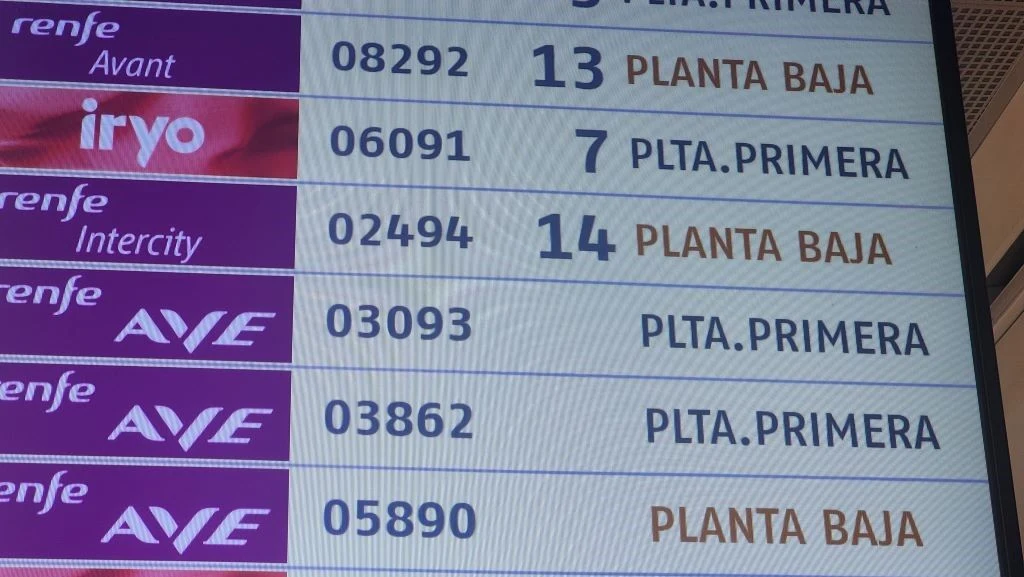
This is the departure screen on level 1 above the Cercanias station lobby.
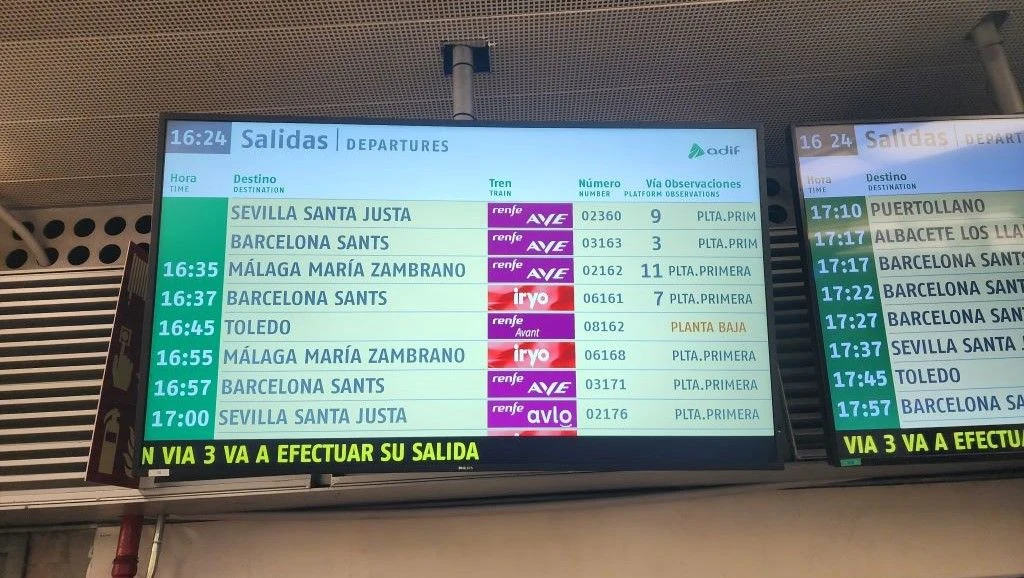
From here the Planta Primera is only a few steps away, but the Planta Baja is down on the level below
(7) You will need to pass through ticket/security checks at the entrances to these departure halls; And queues can inevitably build up at busy times.
Hence the recommendation to be at Atocha and in this queue at least 30 mins prior to departure.
(8) Typically around 30mins ahead of departure the via / platform / track number of the train you will be taking will appear on the departure boards.
You can then proceed to the gate that gives the access to the via / platform / track and wait in line for boarding to begin, it usually commences around 10 mins prior to departure.
(9) The gate will be closed two minutes prior to the departure time.
Using the departure halls / lounge:
There are now two departure halls at Atocha, from which the high speed trains (AVE, Avant, avlo, iryo, Ouigo) departures can be accessed:
- the Planta Baja hall, follow the signs pointing the way to the 'Salidas Plantas Baja'
- the Planta Primera hall, follow the signs pointing the way to the 'Salidas Plantas 1'.
The departure screens throughout the station show which of the two halls you need to pass through in order to access a train, 'Planta Baha or ;Plta. Primera'.
Which of the halls you need to use to await departure will be on the departure screens around the station, ahead of the departure time - and check this info carefully, don't assume you have to follow the crowd!
In usual circumstance the Primera hall on level 1 is the waiting area and access point for vias (platforms / tracks) 1 to 12, used by the
- AVE trains to Barcelona or to Figueres via Barcelona
- AVE trains to Malaga
- AVE or Alvia trains to Seville
- Alvia trains to Cadiz or Jerez
- the iryo, Ouigo and avlo services
In usual circumstances, the Planta Baja hall on level 0 is the waiting area and access point for vias (platforms / tracks) 13 to 15*, typically used by
- the IC trains
- the trains to Toledo
- the AVE trains towards Alicante and Valencia that are still departing from Atocha.
*= The number of vias which can currently be accessed from the Planta Baja has been reduced to the construction work.
Don't assume that that you will need to enter the Primera hall on level 1; particularly if you arrive at Atocha on a local Cercanias train -the entrance to this departure hall in the area above the Cercanias tracks can seem as though it is the only departure hall, but it isn't.
Once you are in the departure halls there is no connection between them, so you will need staff to help you exit and enter the other hall - a scenario which is best avoided
Boarding
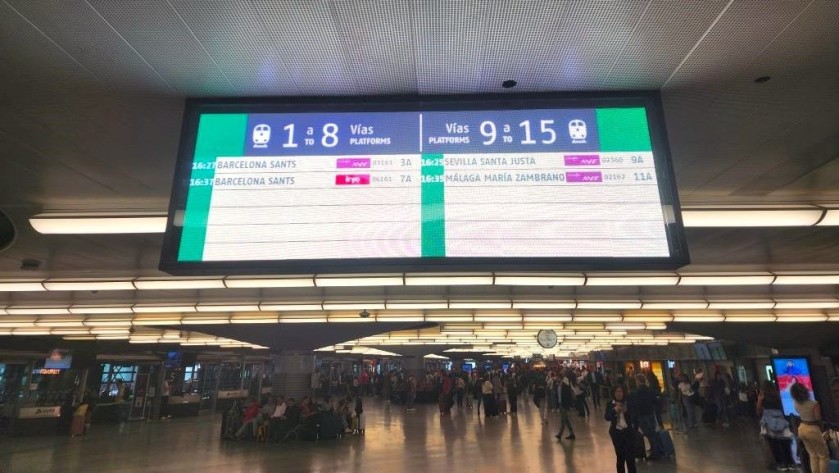

The specific number of the via (platform/track) that your train will be departing from will be confirmed around 20 - 30 minutes ahead of the departure time.
You will need to keep an eye on the departure screens in the departure lounge, as the fact that boarding has commenced will not normally be announced.
There are staffed gates, similar to those at airports, at the entrance to each via (platform/track) where you will need to show your ticket.
The queues of passengers waiting to pass through each gate snake through the departure halls.
The train will depart on time regardless of whether all passengers have passed through the checks.
To facilitate this, the 'gates' will close a few minutes before departure.
Hence it being a good idea to allow plenty of time to catch a high speed train from Atocha.
Both departure halls resemble a provincial airport terminal.
They have banks of seating in which you can wait for the details of your departure to be confirmed and food/drink outlets.
...to the trains from the Planta Primera
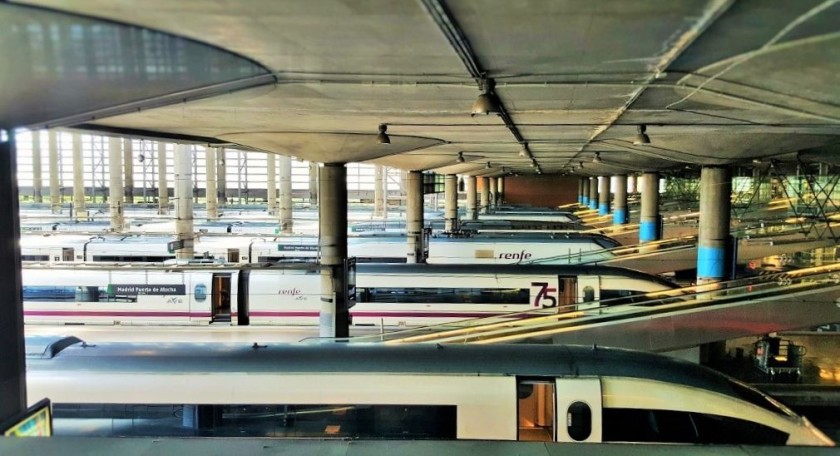

Once you are in the Planta Primera, you will need to pass through a ticket check gate in order to access the train you will be taking,
The number of the via (platform / track) will typically appear on the departure screens around 30 mins ahead of departure, but the ticket gates won't typically open until 10 mins before departure.
Hence queues will form at the ticket gates.
On the other side of the ticket gates are travelators / moving walkways lead down to the trains.
The elevators down to the vias that the trains leave from, can only be used by travellers who have requested mobility assistance.
Accessing the AVE departure halls:
You will need to use either of the two Sala de Embarque', departure halls, if you will be taking an AVE, Avant, avlo, iryo or Ouigo train.
This 'Sala de Embarque' is now on two levels, 0 and 1, but there are operated as two separate halls, so you need to enter the correct hall.
On the departure screens within the station, Planta Baja is the departure hall on level 0 and Planta Primera is the departure hall on level 1.
to the Planta Baja hall
For the level 0 departures area follow the signs to the 'Salidas Plantas Baja' (Departures Ground Floor), it's on the other side of the security check area, which is by the older main hall in the station, between the Cercanias part of the station and the indoor garden area.
When using the entrance by the taxi / car drop off zone (which is the temporary main entrance to the station due to construction work), this Baja depatture hall is at the lowest level of the flights of escalators and walkway, which lead down into the station.
to the Planta Primera hall
The departure area on Level 1 has two entrances, at both of which you will have to pass through security checks in order pass through into the departure hall.
One of these access points to the level 1 Primera departure hall can currently only be accessed when using the entrance by the taxi / car drop off zone - which is the temporary main pedestrian access into Atocha; you descend into it by using the flights of escalators and walkway, which lead down into the station.
The other entrance to the Primera departure hall is the atrium above the Cercanias part of the station.
Though take care to check that your train will be departing from this departure hall prior to entering - when in this part of the station, it can seem as though this is the only departure hall.
when arriving by taxi:

There are usually two taxi drop off areas at Atocha station, but that on level 0 is currently closed due to construction work.
(1) If you arrive by taxi at the main drop off area on level/planta 2, you will be at what has become the temporary main entrance to the part of Atocha used by the long-distance trains.
Go through the doors and there will be escalators and lifts which lead down to the departure halls; though check which of the two halls your train will be accessed from - the Planta Primera is on level 1 and the the Planta Baja is on level 0
(2) Though taxis also drop off at the Level 0; the same level as the indoor garden and ticket office - though not at the current time
If you need to buy a ticket at Atocha, ask the driver to drop you at this entrance by the garden.
The main ticket hall for the AVE and the other larga-distancia trains is by the indoor garden.
From here you will either:
- need to head to the level 0 departure hall, following the signs to the 'Salidas Plantas Baja' - go through the doors which lead into the mall; then turn to the left, OR
- have to use the travellators by the indoor garden, to ascend to the level 1 departure hall, following the signs to 'Salidas Plantas 1'.
when arriving by Cercanias train:

If you arrive by Cercanias train (there are direct Cercanias trains from the airport and Chamartin station); then you will initially need to ascend to the main Cercanias concourse on level 0 by escalator.
One of the departure halls, the plantas baja is on level 0 -So if your train will be leaving from a vias (platforms / tracks) 13 to 15, which can be accessed through this departure hall, remain on this level and enter the mall area of the station.
You will soon come to the security screening area to this Salidas Plantas Baja'' over on the left
If you need to use the 'Salidas Plantas 1' to access your train, you can remain in the atrium of this Cercanias station and ascend to Planta/Level 1 by escalator or elevator.
when arriving by Metro:
If you arrive at Atocha by Metro, you will be walking head from the Metro station area, which is on level 0
If you need to use the level 0 departure hall to access your onward train, follow the signs to the Salidas Plantas Baja' (Departures Ground Floor), the route is to keep going straight ahead towards the main, older hall in the station - on the left you'll soon see the security screening area, which you'll need to pass through.
If you need to the Salidas Plantas 1, the level 1 departure hall, head to the atrium by the Cercanias station and ascend up to level 1.
Buying Tickets for the AVE trains
If you don't want to use a RENFE ticket machine, you will need to buy last minute tickets from the main RENFE ticket office; the ‘Venta De Billetes’
It is located to one side of the indoor garden, so head towards it.
If you arrive at Atocha by Cercanias trains you will initially have to ascend from the via (track/platform, that the Cercanias train will have arrived.
Then once you are up on the concourse in this Cercanias part of the station, you'll then need over to the left and enter the mall area.
The exit from the Metro also leads into this mall area.
Over to the right you'll see some doors to the main hall, which houses the indoor garden, go through them to enter this hall and the ‘Venta De Billetes’ will be on the right hand side.
When you have made your purchase, exit the ticket office into the indoor garden and then turn left to retrace your steps towards the mall.
Before you come to the doors which lead to the mall, there will be an travellator behind you and to the right, it leads up to level 1 in the departure lounge.
Or you can enter the mall, go down the passage way to the left and then over to the right you'll come to a security check area, which is the entrance to level 0 in the departure lounge.
Departing by other express trains:
The high speed trains only depart from the main terminal, the 'Puerta De Atocha', but OTHER longer distance trains can depart from the via/platforms in the Cercanias station – which as its name suggests, is otherwise dominated by the ‘Cercanias’ commuter trains.
If you are taking one of these trains, check the details on the main departure (Salidas) screens carefully - and don’t be surprised if the via/platform is actually in the Cercanias station.
Once you are in the Cercanias station you need to find the somewhat hard to spot ‘larga distancia/media distancia’ departure gate.
Arriving on a high speed train:



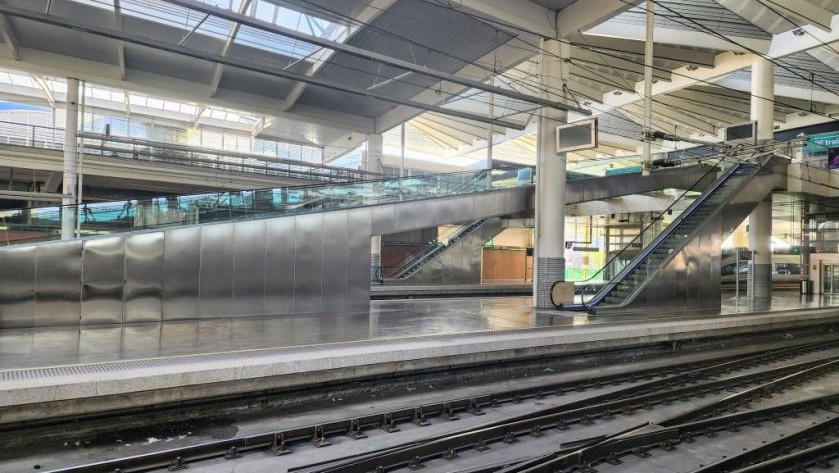
It's almost certain that if you will be arriving by one of the high speed train services to Madrid; the AVE, Altaria and Alvia, avlo, iryo and Ouigo trains, that your train will arrive in the 'Puerta De Atocha' part of the station.
Though how you exit the station, from the Puerta De Atocha can vary between TWO routes.
Route 1:
This is the typical route if your train arrives at vias (platforms/tracks) 2 - 12.
The train will halt towards the far end of the via (platform/track), farthest from the station terminal.
From here it's likely that you will be directed to ascend to an upper level (Level 1), in order to exit from the via (track/platform) which you have just stepped on to.
There are moving walkways and elevators which lead up to level 1.
Don't assume that you will be taking a less convenient route, by having to ascend from where your train will have arrived.
The vias (platforms/tracks) in the high speed station are on level 0, but this is actually below street level.
The route you will be following, which now also features level travellators of the type used in airport terminals, will lead you into a light filled atrium, which is at the side of the main station.
The exits from here, on level 1, are at the same level as the streets which surround the station.
At this level, over to the left is an entrance to the 'Planta Primera' departure hall.
It is you will be connecting into another AVE train heading to Barcelona, Cadiz, Figueres, Malaga, Marseille or Sevilla, it's likely that it's access will be through this hall, though check the departure screens.
Escalators and elevators lead UP in this atrium lead up to the MAIN TAXI RANK on level 2.
Also in this atrium, down below you, on level 0, you will see the concourse which gives access to the Cercanias (local) trains.
So you will need to use the escalators or elevators to descend to this level, if you want to take a Cercanias train to the city centre, Chamartin station or Barajas Airport.
What you won't see, from this Level 1, in the atrium above the Cercanias station, is the other main hall at Atocha station; which houses the indoor garden, the larga-distancia ticket hall and most of the food/drink outlets at the station.
This main hall is on level 0, so you will also need to descend down into the Cercanias concourse to access this area of Atocha station.
The access to the metro station is also on level 0.
If you will be taking the Metro, once you're down on the Cercanias concourse, the route to the Metro station entrance is over to the right.

Route 2:
This is the typical route if your train arrives at vias (platforms/tracks) 13 - 15, but it can be accessed when arriving by any train
You can go straight ahead towards the front of the trains, as you would when taking a train to a terminus station
The exits will lead you out into the mall area of the station, (most which is temporarily closed off) and you turn to the right for the Cercanias and Metro stations.
If you arrive on a train which halts at the far end of the station - then walking down to the far end of the platform is the quickest route to the Metro.
Heading up to level 2 can be the best option if you'll be TAKING A TAXI; the main rank at Atocha is up on level 2.
Also level 1 is the same level as the surrounding streets, so heading up to level 1 is the best option if you'll be continuing your journey on foot.
Arriving on non-high speed express trains:
If you will be travelling to Madrid-Atocha on a non high-speed trains train such as an IC or MD service then these trains can arrive in the OTHER part of Atocha station, which is mainly used by the Cercanias (local) trains.
This part of the station has comparatively easy access to the exits and other connections at Atocha.
To exit from the via (platform/track) that your train will have arrived at, you will have to use the escalators or elevators to ascend up to the Cercanias concourse; on level 0.
From this concourse you can access the Cercanias trains which will be heading to the city centre, Chamartin station or Barajas Airport.
You can also remain on Level 0 to access the Metro.
You will see an atrium leading to the levels above, and this atrium houses escalators and elevators.
Ascend up to level 1 for the street level exits from the station; go up to level 2 to access the main taxi rank at Atocha.
to Chamartin Station from Atocha by train:
These six things are worth knowing about making the transfer from Atocha to Chamartin stations by train.
(1) The Cercanias local trains (not the metro) provide the easiest access to Chamartin station from Atocha.
Both Atocha and Chamartin are served by line 1 of the Madrid Metro, but they are 16 stops apart!
In contrast, the Cercanias trains take less than 10 mins to reach Madrid Chamartin from Atocha.
However, due to the ongoing transformation work at Chamartin station, taking the Metro is currently the way to go, as accessing the long-distance departure hall at Chamartin from the Cercanias arrivals area, is currently a five minute plus walk.
(2) The Cercanias trains use a separate part of Atocha station to the 'Puerta de Atocha' - the main part of the station, which is used by the high speed AVE trains.
When arriving by high speed train, you can exit from the main terminal into this Cercanias station.
IF, when arriving by high speed train in the 'Puerta De Atocha, you ascend up to level 1, in order to exit the from the via (platform/track0: you can descend back down to level 0, in order to access the Cercanias concourse.
(3) You can buy a ticket for the Cercanias trains from the red ticket machines.
The ticket machines have an English translation option - but the names of the tickets remain in Spanish.
If you are going to Chamartin you will need to purchase an ‘Adulta Ina’ ticket.
(4) Cercanias lines C1,C2,C3,C4,C7,C8 and C10 all operate between Atocha and Chamartin station.
Trains to Chamartin on lines C1, C2, C7, C8 and C10 depart from platforms/via 1 and 2 – so from either side of this platform.
But the trains on line C3 and C4 take a different route to Atocha through Sol station, so they depart from platform/via 6.
You haven’t got to be a maths genius to work out that there are theoretically more frequent trains to Chamartin from via 1-2 compared to via 6; but yes you can find yourself stuck for a while on via 1 and 2, while other trains to Chamartin are leaving from via 6.
As far as we could tell there is no 'next train to Chamartin' indicator at Atocha.
(5) It’s a good idea to be at Chamartin around 30 mins before your onward connection departs from there; so for a stress-free transfer aim to arrive at Atocha an hour before your train departs from Chamartin.
Though the train journey between Atocha and Chamartin only takes around 12 minutes.
(6) At Atocha, the escalators and lifts from the Cercanias concourse, will take you down to the part of the via (platform/track) used by the front coaches of the trains.
However, on arrival at Chamartin, the exit up to the departure concourse will be by the rear of the Cercanias train.
So if you have time, move along the via (platform/track) at Atocha prior to boarding.
to Barajas airport by train:
Follow these steps when heading to Barajas Airport by train from Atocha station.
(1) 'Cercanias' (local) trains on line C1 and C10 operate between Barajas airport and Atocha, they depart every 15-30 minutes and 'Aeropuerto' is their final destination.
The journey time is around 20 - 25 minutes.
(2) At Atocha they depart from via/platforms 1 and 2 in the Cercanias station; which is beside the main terminal.
(3) The Cecanias station has a concourse where you can buy a ticket; there are manned ticket desks and multiple machines.
(Eurail and Interrail passes are valid on the Cercanias trains).
(4) Note that not all of the Cercanias trains, which depart from platforms/via 1 and 2, will be the line C-1 and C-10 trains heading to the Aeropuerto; so check the departure indicators and info on the trains.
(5) These line C1 and C10 trains call at a station that’s directly linked to Terminal 4 (the main terminal) of Barajas Airport
(6) However, if you take the C1 train to Barajas and your flight is departing from Terminals 1 or 2 - your journey will be a little more awkward (and confusing).
On arrival by C1 train at Barajas you will see multiple signs pointing the way to Terminal (T4), but none for Terminals T1/T2 at all.
You will pass the entrance to the Metro station at Terminal 4, which is served by line 8.
At this point you have a choice:
- Take the Metro to its station that serves Terminals T1/T2 , but you will need to buy a separate ticket: OR
- Take the free shuttle bus to terminals T1/T2.
However, there aren't initially any signs pointing you in the direction of this shuttle bus.
Head for the bus station and at the top of the escalator you'll see a sign that points to the nearby shuttle bus stop; the first sign you will see that gives any indication that Barajas airport has any other terminals, apart from Terminal 4!
The bus transfer can take 15 mins and we wished we had opted for the Metro - despite the need to buy a metro ticket.
Please support ShowMeTheJourney
This second version of ShowMeTheJourney is exciting and new, so we are genuinely thrilled that you are here and reading this, but we also need your help.
We’re striving not to let anything get in the way of providing the most useful service possible, hence a facility has been set up with DonorBox which can be used to support the running costs and make improvements.
Instead of advertising or paywalls, your financial support will make a positive difference to delivering an enhanced service, as there’s a lot of ideas which we want to make happen.
So if you have found the info provided here to be useful, please go here to say thank you.
Journeys
# Jump to a directionJourneys from Madrid Atocha / Puerta De Atocha
Jump to directionsFrom Madrid to Granada
Madrid to Algeciras by train
Madrid to Avignon by train
Madrid to Barcelona by train
Madrid to Cadiz by train
Madrid to Cordoba by train
Madrid to Girona/Gerona by train
Madrid to Jerez de la Frontera by train
Madrid to Malaga by train
Madrid to Marseille by train
Madrid to Montpellier by train
Madrid to Murcia by train
Madrid to Pamplona by train
Madrid to Paris by train
Madrid to Ronda by train
Madrid to Sevilla / Seville by train
Madrid to Tarragona by train
Madrid to Toledo by train
Madrid to Zaragoza by train
Journeys to Madrid Atocha / Puerta De Atocha
Jump to directionsBarcelona to Madrid by train
Barcelona to Zaragoza by train
Marseille to Madrid by train
Paris to Madrid by train
This second version of ShowMeTheJourney is exciting and new, so we are genuinely thrilled that you are here and reading this, but we also need your help.
We’re striving not to let anything get in the way of providing the most useful service possible, hence a facility has been set up with DonorBox which can be used to support the running costs and make improvements.
Instead of advertising or paywalls, your financial support will make a positive difference to delivering an enhanced service, as there’s a lot of ideas which we want to make happen.
So if you have found the info provided here to be useful, please consider saying thank you.

This is one of more than 100 train travel guides available on ShowMeTheJourney, which will make it easier to take the train journeys you want or need to make. As always, all images were captured on trips taken by ShowMeTheJourney.







